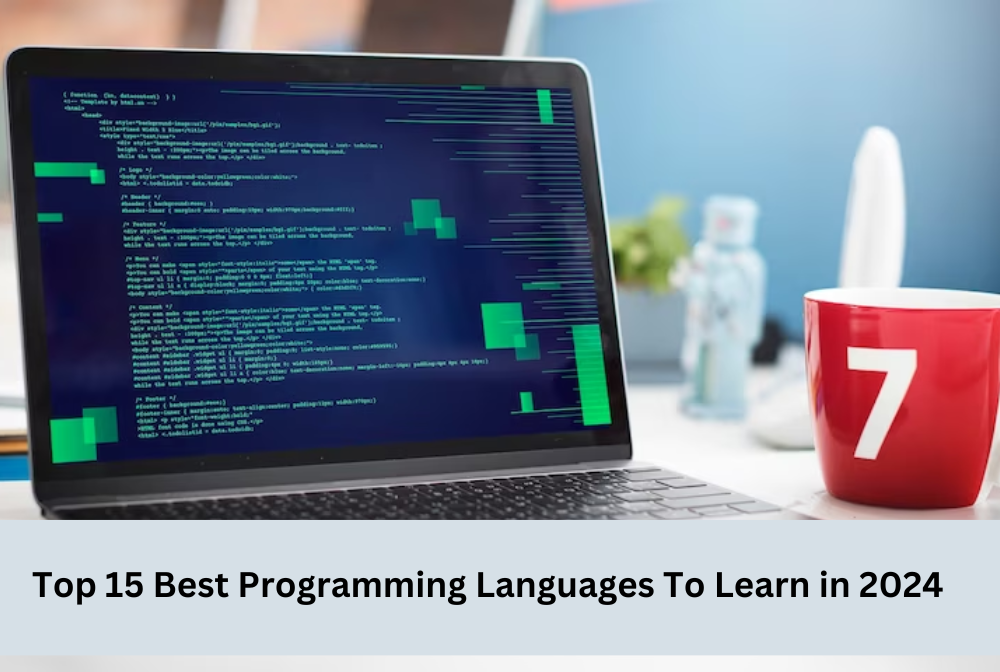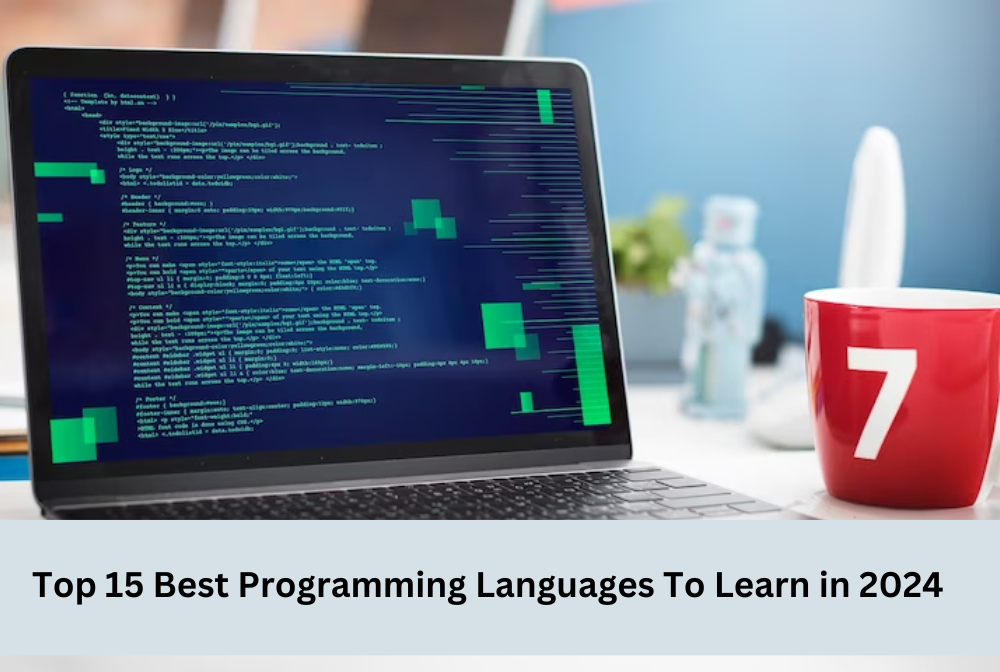In the dynamic realm of technology, programming languages serve as the backbone of innovation, powering everything from software applications to complex algorithms. As we venture into 2024, the landscape of programming languages continues to evolve, with some languages gaining prominence due to their versatility, performance, and applicability across various domains. Whether you're a seasoned developer looking to expand your skill set or a newcomer eager to embark on a programming journey, choosing the right language can significantly impact your career prospects and project success. In this comprehensive guide, we'll explore the top 15 programming languages to learn in 2024, highlighting their benefits, required skills, and popularity within the tech industry.
What is a Programming Language?
A programming language is a structured method of instructing computers to perform specific tasks. It serves as a means of communication between humans and computers, enabling programmers to write code that computers can understand and execute. Essentially, a programming language provides a set of rules and syntax for writing instructions that govern the behavior of a computer program.
Programming languages vary in complexity, purpose, and application. Some languages are designed to be highly readable and easy to learn, making them ideal for beginners, while others are tailored for specialized tasks such as scientific computing, web development, or system administration.
There are several key components that constitute a programming language:
-
Syntax: Syntax refers to the rules and structure of the language. It dictates how statements and commands are written, including the use of keywords, punctuation, and formatting conventions. Syntax errors occur when code does not adhere to these rules.
-
Semantics: Semantics define the meaning behind the code. It specifies how instructions are interpreted and executed by the computer. Understanding the semantics of a language is crucial for writing efficient and error-free code.
-
Variables and Data Types: Programming languages allow programmers to work with different types of data, such as numbers, text, and logical values. Variables are used to store and manipulate data within a program, and data types determine the kind of values that variables can hold.
-
Control Structures: Control structures enable programmers to control the flow of execution within a program. This includes constructs such as loops, conditionals, and branching statements, which allow for decision-making and repetition in code.
-
Functions and Procedures: Functions and procedures are reusable blocks of code that perform specific tasks. They promote modularity and code reuse by encapsulating functionality into manageable units.
-
Libraries and Frameworks: Many programming languages come with built-in libraries or external frameworks that provide pre-written code for common tasks. These resources streamline development and allow programmers to leverage existing solutions to accelerate their projects.
Programming languages can be broadly categorized into different paradigms based on their approach to problem-solving and code organization. Common paradigms include procedural, object-oriented, functional, and declarative programming.
Overall, programming languages serve as the foundation for software development, enabling programmers to create a wide range of applications and solutions to address various computational challenges.
What Are the Best Programming Languages to Learn in 2024?
1. Python:
Python continues to reign supreme as one of the most popular programming languages, revered for its simplicity, readability, and extensive library support. Its versatility enables developers to tackle a myriad of tasks, from web development and data analysis to artificial intelligence and machine learning. Proficiency in Python requires a solid grasp of core concepts such as data structures, algorithms, and object-oriented programming.
2. JavaScript:
JavaScript remains indispensable for web development, powering dynamic and interactive websites across the internet. With the rise of frameworks like React, Angular, and Vue.js, mastering JavaScript opens doors to lucrative opportunities in front-end and full-stack development. Essential skills include understanding DOM manipulation, asynchronous programming, and proficiency in popular frameworks.
3. Java:
Java's robustness and platform independence make it a staple in enterprise-level applications, mobile development (Android), and large-scale systems. Proficiency in Java entails mastering concepts like multithreading, exception handling, and object-oriented programming principles.
4. TypeScript:
TypeScript, a superset of JavaScript, has gained traction due to its static typing and scalability, making large codebases more manageable and less error-prone. It's widely used in building robust web applications, particularly with frameworks like Angular and React.
5. Swift:
Swift is the go-to language for iOS and macOS app development, offering a modern, safe, and efficient alternative to Objective-C. Proficiency in Swift requires familiarity with iOS SDKs, memory management, and design patterns prevalent in Apple ecosystem development.
6. Kotlin:
Kotlin, endorsed by Google as the preferred language for Android app development, combines conciseness with interoperability, enabling developers to write safer and more expressive code. It seamlessly integrates with existing Java codebases and offers features like null safety and extension functions.
7. C#:
C# remains a dominant force in game development, thanks to the Unity game engine, and enterprise-level applications built on the .NET framework. Mastery of C# involves understanding concepts like LINQ, asynchronous programming, and Unity game development fundamentals.
8. Go (Golang):
Go's simplicity, efficiency, and built-in support for concurrency make it an ideal choice for building scalable and high-performance backend systems. It's widely used in cloud-native applications, microservices, and containerization projects.
9. Rust:
Rust has gained popularity for its emphasis on safety, performance, and memory management without sacrificing speed. It's well-suited for systems programming, where low-level control and memory safety are paramount.
10. SQL:
Structured Query Language (SQL) remains indispensable for managing and querying relational databases, playing a crucial role in data-driven applications and analytics. Proficiency in SQL involves mastering database design, normalization, and complex queries.
11. R:
R continues to be the language of choice for statistical analysis, data visualization, and machine learning in academia and industry. Its extensive library ecosystem, including packages like ggplot2 and caret, empowers data scientists to derive insights from complex datasets.
12. Ruby:
Ruby's elegant syntax and focus on developer happiness make it a favorite among web developers, particularly with the Ruby on Rails framework. Proficiency in Ruby entails understanding MVC architecture, RESTful APIs, and RubyGems.
13. PHP:
Despite criticisms, PHP remains ubiquitous in web development, powering a significant portion of the internet's dynamic content. Proficiency in PHP involves mastering server-side scripting, database integration, and popular frameworks like Laravel and Symfony.
14. C++:
C++ retains its significance in performance-critical applications, including game development, operating systems, and embedded systems. Proficiency in C++ requires a deep understanding of memory management, pointers, and object-oriented programming.
15. Scala:
Scala's fusion of functional and object-oriented paradigms makes it a compelling choice for building scalable and resilient applications on the Java Virtual Machine (JVM). It's widely used in big data processing frameworks like Apache Spark.
Conclusion:
In the ever-expanding universe of programming languages, the choice of which to learn depends on factors such as career aspirations, project requirements, and personal preferences. By mastering one or more of the top programming languages highlighted in this guide, you can position yourself for success in the tech industry, whether you aspire to become a web developer, data scientist, game programmer, or systems architect. Keep in mind that the most valuable skill for any programmer isn't just proficiency in a specific language but the ability to adapt, learn continuously, and solve problems creatively in an ever-changing technological landscape. So, embark on your programming journey with enthusiasm, curiosity, and a commitment to lifelong learning.
How to Get Started?
While there exists a multitude of programming languages, only a select few earn a coveted position on the shortlist of essential languages for aspiring programmers. Among these, the ones highlighted above stand out as premier choices for programmer training. Whether you're embarking on a career switch, seeking advancement in your current role, or aiming to broaden your skill set, mastering one of these languages serves as a strategic starting point for your journey.
With a curriculum catering to beginners exploring Python and seasoned professionals delving into Java, there's a fitting course for every learner. When you're ready to take the leap into learning a new language, turn to Knowmerit for comprehensive training and certification services. Our offerings encompass all seven of these core languages—Java, JavaScript, C, C#, Python, Swift, and Ruby—alongside others. Crafted by industry experts, our courses prioritize practical learning experiences and come with round-the-clock support. By completing our programs, you not only acquire proficiency in the language of your choice but also gain the credibility of certification, bolstering your prospects in securing lucrative programming roles.
Should you have any inquiries or require assistance, don't hesitate to reach out by leaving a comment below. Our dedicated team stands ready to address your concerns promptly.
Frequently Asked Questions (FAQs) About Top Programming Languages in 2024:
1. Which programming language should I learn first?
- It depends on your interests and career goals. For web development, consider starting with HTML, CSS, and JavaScript. For data science, Python is an excellent choice. If you're interested in mobile app development, Swift (for iOS) or Kotlin (for Android) are great options.
2. Are there any programming languages that are becoming obsolete in 2024?
- While some languages may not be as popular as they once were, very few become completely obsolete. Technologies evolve, and languages adapt. However, staying updated with industry trends can help you prioritize learning languages that are in high demand.
3. How long does it take to learn a programming language?
- The time it takes to learn a programming language varies depending on factors such as your prior experience, the complexity of the language, and the amount of time you dedicate to learning. With consistent practice and dedication, you can gain proficiency in a language in a few months to a year.
4. What resources are available for learning these programming languages?
- There are numerous resources available, including online tutorials, documentation, books, coding bootcamps, and community forums. Websites like Codecademy, Udemy, Coursera, and freeCodeCamp offer structured courses for beginners and advanced learners alike.
5. How can I stay updated with the latest trends in programming languages?
- Follow industry blogs, subscribe to tech newsletters, participate in online forums like Stack Overflow and Reddit, attend conferences and meetups, and engage with the programming community on social media platforms like Twitter and LinkedIn.





